Nunix
On this page, you find all documents, package deals, and flashcards offered by seller NUNIX.
- 587
- 0
- 0
Community
- Followers
- Following
587 items
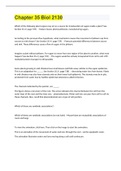
Chapter 35 Biol 2130
Chapter 35 Biol 2130 Imagine a plant without phloem. For sugars to move from one region of the plant to another, what must happen? See Section 35.4 ( page 739) . - The sugars would be actively transported from cell to cell. ATP-mediated protein transport is still possible.
- Exam (elaborations)
- • 10 pages •
Chapter 35 Biol 2130 Imagine a plant without phloem. For sugars to move from one region of the plant to another, what must happen? See Section 35.4 ( page 739) . - The sugars would be actively transported from cell to cell. ATP-mediated protein transport is still possible.
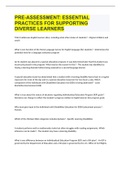
PRE-ASSESSMENT: ESSENTIAL PRACTICES FOR SUPPORTING DIVERSE LEARNERS
PRE-ASSESSMENT: ESSENTIAL PRACTICES FOR SUPPORTING DIVERSE LEARNERS
- Exam (elaborations)
- • 6 pages •
PRE-ASSESSMENT: ESSENTIAL PRACTICES FOR SUPPORTING DIVERSE LEARNERS
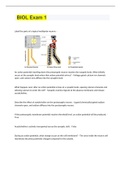
BIOL Exam 1
What happens next, after an action potential arrives at a synaptic knob, opening calcium channels and allowing calcium to enter the cell? - Synaptic vesicles migrate to the plasma membrane and release acetylcholine.
- Exam (elaborations)
- • 7 pages •
What happens next, after an action potential arrives at a synaptic knob, opening calcium channels and allowing calcium to enter the cell? - Synaptic vesicles migrate to the plasma membrane and release acetylcholine.
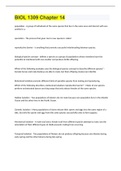
BIOL 1309 Chapter 14
BIOL 1309 Chapter 14 biological species concept - defines a species as a group of populations whose members have the potential to interbreed with one another and produce fertile offspring. Which of the following examples uses the biological species concept to describe different species? - Female horses and male donkeys are able to mate, but their offspring (mules) are infertile. Behavioral isolation prevents different birds-of-paradise species from mating and reproducing. Which of the fo...
- Exam (elaborations)
- • 10 pages •
BIOL 1309 Chapter 14 biological species concept - defines a species as a group of populations whose members have the potential to interbreed with one another and produce fertile offspring. Which of the following examples uses the biological species concept to describe different species? - Female horses and male donkeys are able to mate, but their offspring (mules) are infertile. Behavioral isolation prevents different birds-of-paradise species from mating and reproducing. Which of the fo...
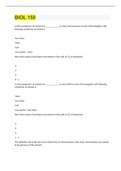
BIOL 150
How many copies of each gene are present in skin cells at G1 of interphase? 6 2 4 8 - 2 A cell in prophase I of meiosis has ____________ as much DNA as each of the daughter cells following cytokinesis of meiosis II. twice four times half one quarter - four times
- Exam (elaborations)
- • 20 pages •
How many copies of each gene are present in skin cells at G1 of interphase? 6 2 4 8 - 2 A cell in prophase I of meiosis has ____________ as much DNA as each of the daughter cells following cytokinesis of meiosis II. twice four times half one quarter - four times
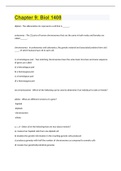
Chapter 9: Biol 1408
chromosomes - In prokaryotes and eukaryotes, the genetic material and associated proteins form a(n) ____, of which humans have 46 in each cell. c) a homologous pair - Two matching chromosomes have the same basic structure and same sequence of genes are called a) a heterologous pair b) a homozygous pair c) a homologous pair d) a heterozygous pair sex chromosomes - Which of the following can be used to determine if an individual is male or female?
- Exam (elaborations)
- • 11 pages •
chromosomes - In prokaryotes and eukaryotes, the genetic material and associated proteins form a(n) ____, of which humans have 46 in each cell. c) a homologous pair - Two matching chromosomes have the same basic structure and same sequence of genes are called a) a heterologous pair b) a homozygous pair c) a homologous pair d) a heterozygous pair sex chromosomes - Which of the following can be used to determine if an individual is male or female?
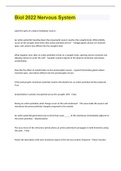
Biol 2022 Nervous System
Biol 2022 Nervous System
- Exam (elaborations)
- • 7 pages •
Biol 2022 Nervous System
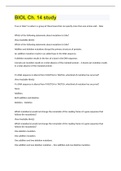
BIOL Ch. 14 study
If a DNA sequence is altered from TAGCTGA to TAGTGA, what kind of mutation has occurred? View Available Hint(s) If a DNA sequence is altered from TAGCTGA to TAGTGA, what kind of mutation has occurred? None. Addition. Both addition and deletion. Deletion. - Deletion
- Exam (elaborations)
- • 19 pages •
If a DNA sequence is altered from TAGCTGA to TAGTGA, what kind of mutation has occurred? View Available Hint(s) If a DNA sequence is altered from TAGCTGA to TAGTGA, what kind of mutation has occurred? None. Addition. Both addition and deletion. Deletion. - Deletion
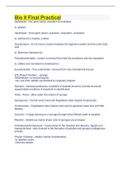
Bio II Final Practical.
Bio II Final Practical. Pseudocoelomates - coelom is derived from both the endoderm and the mesoderm ie. rotifers and roundworms (hookworms) Eucoelomates - True coelomates - derived from only mesodermal tissues. [27] Phylum Porifera - -sponge -Multicellular; no tissues/organs -can vary from radially symmetrical to irregularly shaped.
- Exam (elaborations)
- • 19 pages •
Bio II Final Practical. Pseudocoelomates - coelom is derived from both the endoderm and the mesoderm ie. rotifers and roundworms (hookworms) Eucoelomates - True coelomates - derived from only mesodermal tissues. [27] Phylum Porifera - -sponge -Multicellular; no tissues/organs -can vary from radially symmetrical to irregularly shaped.
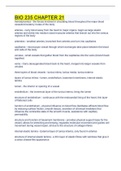
BIO 235 CHAPTER 21
capillaries - microscopic vessel through which exchanges take place between the blood and cells of the body venules - small vessels that gather blood from the capillaries into the veins (branch back together) veins - Carry deoxygenated blood back to the heart, merged into larger vessels from venules
- Exam (elaborations)
- • 13 pages •
capillaries - microscopic vessel through which exchanges take place between the blood and cells of the body venules - small vessels that gather blood from the capillaries into the veins (branch back together) veins - Carry deoxygenated blood back to the heart, merged into larger vessels from venules
